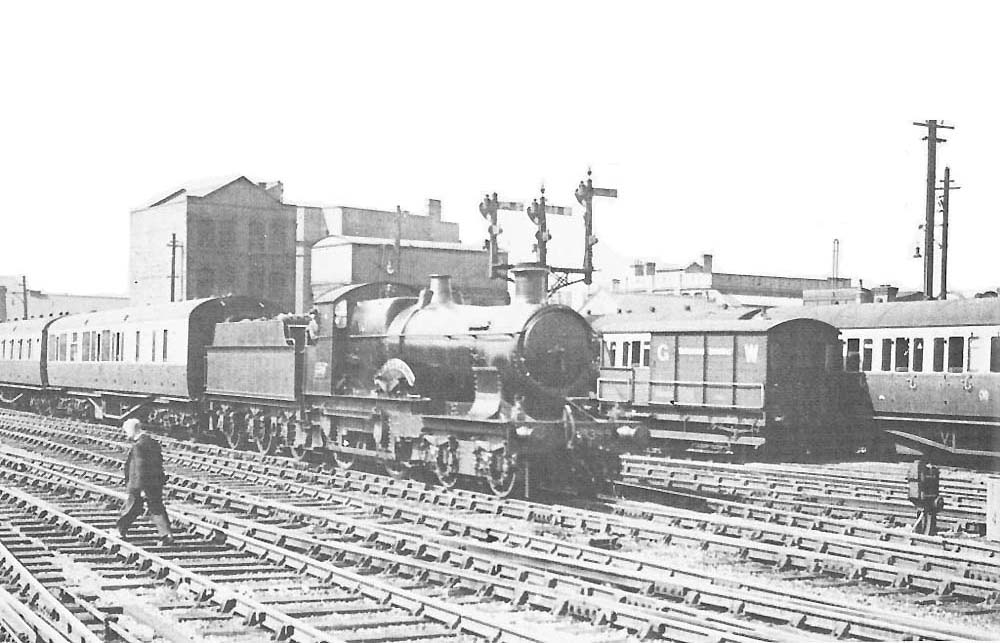 |
|
GWR Route: Banbury to Wolverhampton
GWR Route: North Warwickshire Line
Birmingham Snow Hill Station: gwrbsh1759
 |
Great Western Railway 33xx (Bulldog) class 4-4-0 No 3399
'Ottawa' with an up express destined for Stratford-upon-Avon approaches the
north end of Snow Hill Station in the Summer of 1938. The first coach is a
ganged corridor brake third (diagram D127) with the deep windows on the
corridor side of the coach extending almost from the cantrail to the waist.
This was the recently introduced sixty-one foot long, large windowed
‘sunshine’ excursion stock. Behind the locomotive in the new yard
sidings is a brake van (telegraphic code Toad) and some older non-corridor
suburban coach stock. This locomotive was built at Swindon Works in February
1904 as part of lot 148. The locomotive originally carried No 3461, but this
was changed in December 1912 as part of the general renumbering scheme designed
to group locomotives of a similar power together. The locomotive was built with
a Churchward Standard No 2 short coned domeless boiler with a belpaire firebox
(D2 type).
This was changed to a Standard No 2 fully coned domeless
boiler (type D3) in March 1907 and in December 1910, the locomotive was fitted
with a boiler with a 12/72 type (12 tube and 72 element) superheater. Top feed
apparatus appeared a few years later. Along with these physical improvements to
the design, boiler pressure was also gradually increased, until it was
standardised at 200 lbs. This gave a tractive effort at 85% of 21,060 lbs and
placed these locomotives in Power Group B. The design changes had also
increased the overall weight and the maximum axle weight was 17 tons, 12 cwt,
which restricted these locomotives to the main lines and some branch lines
(Blue routes). In 1934, No 3399 was paired with a diagram A17, 3,000 gallon
tender (No 1017). This tender was built in 1893, ten years before the
locomotive, but was at Swindon having its coal rails replaced with solid
fenders when the locomotive was built, so this locomotive and tender may have
been paired together since 1904. The tender shown in the picture is a 3500
gallon one, and the cabsheets of the loco have been flared out at the rear to
match the bodywidth of the tender. Russ Elliott writes, 'Subsequent to the 1934 pairing with a 3000g tender, it was
fitted with a 3500g one, as depicted in the picture. (In time-honoured GWR
fashion of passing down tenders from the tender pool, many Bulldogs were
inheriting 3500g tenders from the larger express locos at the time, the latter
being paired with newer 4000g ones.) It's a complex saga, but I suggest
something like the following is added to the end of the second para: "The
tender shown in the picture is a 3500 gallon one, and the cabsheets of the loco
have been flared out at the rear to match the bodywidth of the
tender'.
The locomotive was originally allocated to Oxford shed
(OXF) for secondary passenger duties. In January 1921, No 3399 was known to
have been allocated to Swindon works (SDN). While in both January 1934 and
January 1938, this locomotive was known to have been allocated to Banbury Shed
(BAN). By this time the 4-6-0 mixed traffic 'Hall' class locomotives were
displacing the 'Bulldog' class locomotives from their traditional role and they
were being used for all kinds of subsidiary roles, including main line freight
work such as coal traffic and perishable specials. No 3399 was finally
withdrawn from Chester shed (CHR) in October 1947. Following this, Mr JB Thorn,
the European Manager of Canadian National Railways, arranged with the Great
Western Railway for the nameplate to be shipped to Canada on board White Star
Liner 'SS Asia' and the nameplate was officially donated to the City of Ottawa
in November 1948. In 2010, the nameplate and presentation plaque were
repatriated to the UK for auction.
Robert Ferris
 back back

|
